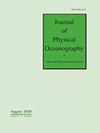论风驱动海岸上升流的路径:非线性动量通量和巴罗克林不稳定性
IF 3
2区 地球科学
Q1 OCEANOGRAPHY
引用次数: 0
摘要
由风驱动的富含营养物质的冷水上升流是主要大洋盆地东部边界附近的一个主要特征,对当地物理环境和海洋生态系统具有重要影响。尽管传统上将上升流描述为对海面离岸埃克曼输运的被动响应,但最近的观测发现,不同上升流位置的环流结构存在空间差异。然而,对支配沿岸上升流空间模式的因素仍缺乏系统的了解。在这里,我们证明沿岸上升流的路径受到两对竞争因素的影响。第一对竞争发生在风力和涡动量通量之间,风力和涡动量通量塑造了欧拉平均环流;第二对竞争发生在欧拉平均环流和由涡引起的环流之间。在倾斜地形上,非线性涡动量的重要性可以用局部坡度伯格数 S = αN/f 来描述,其中 α 是地形坡角,N 和 f 是浮力频率和科里奥利频率。当 S 较小时,残余环流中会出现典型的沿岸上升流结构,即海水沿坡底上升。然而,这也增加了复杂性,即中尺度漩涡可能会推动潜流返回海洋内部。随着 S 的增加,上升流分支越来越受到抑制,无法到达海面,而是被漩涡引起的环流引向近海。进一步探讨了上升流结构对可变风应力和表面浮力强迫的敏感性。这种诊断方法有助于提高我们对沿岸上升流系统的认识,并能在粗分辨率数值模式中对沿岸 上升流进行更实际的描述。本文章由计算机程序翻译,如有差异,请以英文原文为准。
On the Pathways of Wind-Driven Coastal Upwelling: Nonlinear Momentum Flux and Baroclinic Instability
Wind-driven upwelling of cold, nutrient-rich water is a key feature near the eastern boundaries of major ocean basins, with significant implications for the local physical environment and marine ecosystems. Despite the traditional two-dimensional description of upwelling as a passive response to surface offshore Ekman transport, recent observations have revealed spatial variability in the circulation structures across different upwelling locations. Yet, a systematic understanding of the factors governing the spatial patterns of coastal upwelling remains elusive. Here, we demonstrate that coastal upwelling pathways are influenced by two pairs of competing factors. The first competition occurs between wind forcing and eddy momentum flux, which shapes the Eulerian-mean circulation; the second competition arises between the Eulerian-mean and eddy-induced circulation. The importance of nonlinear eddy momentum flux over sloping topography can be described by the local slope Burger number, S = αN/f, where α is the topographic slope angle and N and f are the buoyancy and Coriolis frequencies. When S is small, the classic coastal upwelling structure emerges in the residual circulation, where water upwells along the sloping bottom. However, this comes with the added complexity that mesoscale eddies may drive a subduction route back into the ocean interior. As S increases, the upwelling branch is increasingly suppressed, unable to reach the surface and instead directed offshore by the eddy-induced circulation. The sensitivity of upwelling structures to variable wind stress and surface buoyancy forcing is further explored. The diagnostics may help to improve our understanding of coastal upwelling systems and yield a more physical representation of coastal upwelling in coarse-resolution numerical models.
求助全文
通过发布文献求助,成功后即可免费获取论文全文。
去求助
来源期刊
CiteScore
2.40
自引率
20.00%
发文量
200
审稿时长
4.5 months
期刊介绍:
The Journal of Physical Oceanography (JPO) (ISSN: 0022-3670; eISSN: 1520-0485) publishes research related to the physics of the ocean and to processes operating at its boundaries. Observational, theoretical, and modeling studies are all welcome, especially those that focus on elucidating specific physical processes. Papers that investigate interactions with other components of the Earth system (e.g., ocean–atmosphere, physical–biological, and physical–chemical interactions) as well as studies of other fluid systems (e.g., lakes and laboratory tanks) are also invited, as long as their focus is on understanding the ocean or its role in the Earth system.

 求助内容:
求助内容: 应助结果提醒方式:
应助结果提醒方式:


